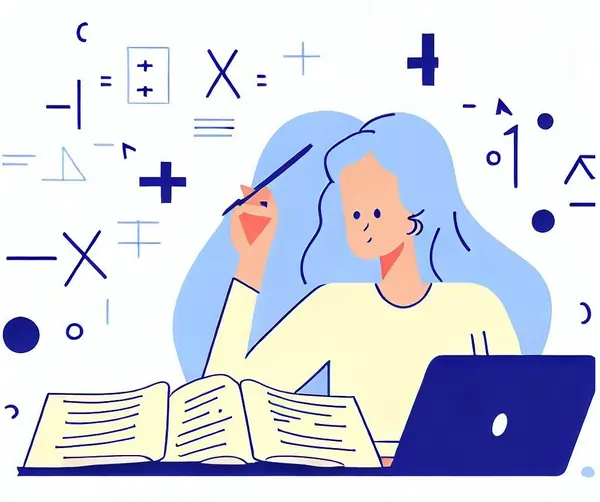Key Points to Consider When Doing Your Linear Algebra Assignments

Linear Algebra serves as the bedrock for various mathematical applications, spanning disciplines from engineering to computer science. When embarking on assignments in this field, whether it's about completing your linear algebra assignment, a solid grasp of foundational concepts and effective problem-solving techniques is paramount. In this article, we will explore the fundamental topics you must be acquainted with before tackling a Linear Algebra assignment. Furthermore, we will provide you with a comprehensive strategy to effectively solve problems within this domain, ensuring your success in navigating the complexities of Linear Algebra.
Core Concepts in Solving Linear Algebra Assignments
Linear Algebra forms the cornerstone of mathematics that underpins a wide array of fields, from engineering to computer science, physics to economics. Its concepts are instrumental in understanding the properties of vectors, matrices, and systems of linear equations. When approaching assignments in Linear Algebra, a solid grasp of fundamental topics and effective problem-solving strategies is essential. Now we'll delve into the key topics you should be familiar with before tackling a Linear Algebra assignment with a systematic approach to solving problems within the discipline.

Fundamental Topics for Linear Algebra Assignments
- Vectors and Vector Spaces: Vectors are mathematical entities characterized by magnitude and direction, used to represent quantities like velocity and force. In Linear Algebra, vectors play a pivotal role as fundamental building blocks. A vector space is a collection of vectors that follow specific rules, encompassing properties like closure under addition and scalar multiplication. Understanding vector operations and the concept of linear combinations is crucial to grasp the broader context of vector spaces and their applications.
- Matrices and Matrix Operations: Matrices are structured arrangements of numbers, often used to represent transformations and organize data. Matrix operations include addition, subtraction, and multiplication, where the latter combines transformations. Determinants measure the scaling factor of transformations, while inverses enable the reversal of transformations. Matrices form the basis for solving systems of linear equations, making them a central topic in Linear Algebra with applications across fields.
- Systems of Linear Equations: Systems of linear equations involve multiple equations with the goal of finding values that satisfy all equations simultaneously. This arises in diverse scenarios, from engineering to economics. Gaussian elimination and row reduction are techniques used to transform systems into simpler forms, revealing solutions. Solutions can be unique, nonexistent, or infinite based on the properties of the system. Solving such systems provides insights into intersecting lines or planes and underpins broader concepts in Linear Algebra.
- Eigenvalues and Eigenvectors: Eigenvalues and eigenvectors are fundamental concepts in Linear Algebra that have wide-ranging applications. Eigenvalues are scalar values that represent how a linear transformation stretches or compresses a vector. Eigenvectors are the corresponding non-zero vectors that remain in the same direction after the transformation. These concepts are crucial in understanding dynamic systems, stability analysis, and diagonalizing matrices. They play a pivotal role in fields like quantum mechanics, engineering simulations, and data analysis, enabling us to simplify complex problems by focusing on the most important aspects of a transformation.
- Linear Transformations: Linear transformations are functions that preserve vector operations, forming the backbone of various mathematical applications. A linear transformation takes a vector from one vector space to another while preserving the properties of addition and scalar multiplication. Transformation matrices represent these operations and can perform tasks like rotation, scaling, and reflection in computer graphics, image processing, and physics simulations. Understanding the kernel (null space) and image (range) of a linear transformation helps analyze its effects on vectors. Linear transformations connect theoretical concepts to practical problem-solving across multiple disciplines.
Strategies for Solving Linear Algebra Assignments
- Conceptual Understanding Comes First
- Break Down the Problem
- Practice with Variety
- Annotate Your Work
- Collaborate and Seek Help
- Apply Real-World Contexts
Before delving into the intricacies of Linear Algebra problem-solving, it's crucial to establish a solid foundation of conceptual understanding. Linear Algebra isn't just about performing calculations; it's about grasping the underlying principles that govern vector spaces, matrices, and transformations.
A strong conceptual grasp allows you to approach problems with clarity. Instead of memorizing formulas, you'll understand why they work, enabling you to adapt them to different scenarios. Start by studying definitions, theorems, and proofs. Consider the geometric interpretations of concepts like vectors and linear transformations – these visualizations often provide valuable insights into abstract ideas.
Conceptual understanding also aids in troubleshooting. When you encounter a roadblock in a problem, you can backtrack to the core principles and identify where the misunderstanding might have occurred. This approach not only enhances your problem-solving skills but also fosters a deeper appreciation for the elegance of Linear Algebra's theoretical framework.
Facing a complex Linear Algebra problem can be daunting, but breaking it down into manageable steps makes the task more approachable. Begin by carefully reading the problem and identifying the key components. Separate the problem into smaller sub-problems, each focusing on a specific aspect.
For instance, when solving a system of linear equations, start by determining the most efficient solution method – Gaussian elimination, matrix inverses, or another technique. Next, break down the steps required for the chosen method. This systematic approach prevents confusion and reduces the chances of overlooking crucial details.
Breaking down problems also aids in error detection. If you make a mistake along the way, isolating the step where the error occurred simplifies the debugging process. Additionally, this approach fosters a logical progression of thoughts, making it easier to articulate your solutions and explanations coherently.
Becoming proficient in Linear Algebra requires consistent and diverse practice. Begin with basic problems to solidify fundamental concepts, and gradually move on to more complex challenges. The goal is not just to memorize solutions, but to develop an intuitive understanding of how concepts interconnect.
Practice hones your problem-solving skills and builds your confidence. It exposes you to different scenarios, helping you recognize patterns and develop a toolbox of strategies. Tackle problems from various sources – textbooks, online platforms, and class notes – to expose yourself to different problem styles.
When you encounter difficulties, resist the urge to immediately seek solutions. Instead, engage in active problem-solving. Experiment with different approaches, seek alternative methods, and explore variations of the problem. This exploration nurtures your creativity and problem-solving adaptability.
In essence, mastering Linear Algebra through practice is like learning a language. Just as using a language in various contexts enhances your fluency, solving a variety of problems strengthens your prowess in applying Linear Algebra principles.
Annotating your work during the process of solving Linear Algebra problems is a powerful strategy that enhances both comprehension and error identification. By providing explanations and reasoning for each step, you solidify your understanding of the underlying concepts. This practice forces you to articulate your thought process, revealing any gaps or misconceptions in your knowledge. Annotated solutions also serve as a valuable resource for reviewing later, saving you time when revisiting similar problems.
When annotating, break down each step in a clear and concise manner. State the reason behind each action, referencing relevant theorems or properties. If you encounter difficulties or make errors, your annotations act as a guide to trace back and identify where things went wrong. This method promotes active engagement, transforming problem-solving into a learning opportunity. As you revisit your annotations, you'll notice your problem-solving skills improving, leading to a deeper understanding of the subject matter.
Collaboration and seeking help are essential aspects of mastering Linear Algebra assignments. Don't hesitate to engage with peers, instructors, or online communities when facing challenging problems. Exploring diverse perspectives can often shed light on new solution paths you might not have considered.
When collaborating, aim for active participation rather than passive acceptance of solutions. Discuss the problem, exchange ideas, and challenge each other's reasoning. This approach cultivates critical thinking and deeper understanding. However, ensure your collaboration remains ethical – the goal is to learn and grow, not to copy solutions.
If you encounter roadblocks that collaborative efforts can't overcome, seek guidance from professors or tutors. They possess a wealth of knowledge and experience to steer you in the right direction. Remember, seeking help isn't a sign of weakness; it's a proactive step toward overcoming obstacles and expanding your knowledge base.
Applying real-world contexts to Linear Algebra concepts bridges the gap between theory and practice. By visualizing how abstract notions manifest in concrete scenarios, you gain a more intuitive grasp of the subject. Real-world applications also make learning more engaging and relevant.
Consider scenarios like using linear transformations to manipulate images in computer graphics or understanding eigenvalues in the context of stability analysis in physics. These connections deepen your understanding and demonstrate the practicality of Linear Algebra in various fields.
When approaching assignments, try to relate the problem to a real-world situation. This not only helps you comprehend the problem better but also equips you with the skills to apply Linear Algebra in your future endeavors. Remember, understanding the "why" behind a concept often comes easier when you can see how it solves real problems.
Conclusion
In conclusion, embarking on a journey through Linear Algebra assignments demands a strong foundational understanding of its key concepts and a strategic approach to problem-solving. As we've explored, mastering topics like vectors, matrices, systems of linear equations, eigenvalues, eigenvectors, and linear transformations is not only essential for acing assignments but also for building a robust skill set applicable across diverse disciplines.
By nurturing a deep conceptual comprehension, breaking down complex problems into manageable steps, and consistently practicing with a variety of scenarios, you can enhance your prowess in Linear Algebra. The power of annotation cannot be underestimated – explaining your steps and rationale reinforces your understanding and minimizes errors. Collaborating with peers and seeking guidance when needed enriches your perspectives and fosters a dynamic learning process.
Furthermore, contextualizing theoretical concepts within real-world scenarios breathes life into the subject, making it relatable and engaging. Linear Algebra's significance in fields like graphics, physics, and data analysis becomes evident, underscoring the practicality of your studies.
Armed with a toolkit of foundational knowledge and effective problem-solving strategies, you'll not only conquer assignments but also unlock the door to a realm of applications. Linear Algebra, with its intricate interplay of abstract concepts and tangible applications, becomes a gateway to analytical thinking and creative problem-solving skills that extend far beyond the classroom, enriching your intellectual journey.